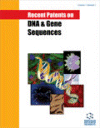- Home
- A-Z Publications
- Recent Patents on DNA & Gene Sequences (Discontinued)
- Previous Issues
- Volume 7, Issue 2, 2013
Recent Patents on DNA & Gene Sequences (Discontinued) - Volume 7, Issue 2, 2013
Volume 7, Issue 2, 2013
-
-
GapMis: a Tool for Pairwise Sequence Alignment with a Single Gap
More LessAuthors: Tomas Flouri, Kimon Frousios, Costas S. Iliopoulos, Kunsoo Park, Solon P. Pissis and German TischlerMotivation: Pairwise sequence alignment has received a new motivation due to the advent of recent patents in next-generation sequencing technologies, particularly so for the application of re-sequencing---the assembly of a genome directed by a reference sequence. After the fast alignment between a factor of the reference sequence and a high-quality fragment of a short read by a short-read alignment program Read More
-
-
-
Pattern Matching in Indeterminate and Arc-Annotated Sequences
More LessAuthors: Md Tanvir Islam Aumi, Tanaeem M. Moosa and M. Sohel RahmanIn this paper, we present efficient algorithms for finding indeterminate Arc-Annotated patterns in indeterminate Arc-Annotated references. Our algorithms run in O(m + nm/w) time where n and m are respectively the length of our reference and pattern strings and w is the target machine word size. Here we have assumed the alphabet size to be constant, because, indeterminate Arc-Annotated sequences are used to mode Read More
-
-
-
Genetic Algorithms with Permutation Coding for Multiple Sequence Alignment
More LessAuthors: Mohamed Tahar Ben Othman and Gamil Abdel-AzimMultiple sequence alignment (MSA) is one of the topics of bio informatics that has seriously been researched. It is known as NP-complete problem. It is also considered as one of the most important and daunting tasks in computational biology. Concerning this a wide number of heuristic algorithms have been proposed to find optimal alignment. Among these heuristic algorithms are genetic algorithms (GA). The GA has m Read More
-
-
-
A Computational Approach to Finding RNA Tertiary Motifs in Genomic Sequences: A Case Study
More LessAuthors: Kevin Byron, Christian Laing, Dongrong Wen and Jason T.L. WangMotif finding in DNA, RNA and proteins plays an important role in life science research. Recent patents concerning motif finding in biomolecular data are recorded in the DNA Patent Database which serves as a resource for policy makers and members of the general public interested in fields like genomics, genetics and biotechnology. In this paper, we present a computational approach to mining for RNA tertiary motifs in geno Read More
-
-
-
Extraction of Infrequent Simple Motifs from a Finite Set of Sequences using a Lattice Structure
More LessAuthors: Tarek El-Falah, Thierry Lecroq and Mourad ElloumiIn this paper we present a method for finding infrequent simple motifs in a finite set of sequences. The method uses a lattice structure and minimal forbidden patterns. It is based on a method for solving the Simple Motif Problem and has the potential to discover new patents in biological macromolecules. Indeed, the extracted motifs can help biologists to learn about the biological functions of these macromolecules and, c Read More
-
-
-
Negative Information for Building Phylogenies
More LessAuthors: Supaporn Chairungsee and Maxime CrochemoreAn absent word (also called a forbidden word or an unword in other contexts) in a sequence is a segment that does not appear in the given sequence. It is a minimal absent word if all its proper factors occur in the given sequence. In this article, we review the concept of minimal absent words, which includes the notion of shortest absent words but is much stronger. We present an efficient method for computing the mini Read More
-
-
-
Patented Biotechnological Applications of Serpin: an Update
More LessAuthors: Nadia Gaci, Dragana Dobrijevic, Samira Boudebbouze, Bouziane Moumen, Emmanuelle Maguin and Moez RhimiThe Serine Protease Inhibitors (Serpins) have been a focus of research by biomedical industries due to their critical role in human health. The use of serpin in the treatment of many diseases was widely investigated through the identification of new genes encoding these proteins in all kingdoms of life. The characterization of these genes revealed that they encoded proteins having low sequence homologies. Future developments Read More
-
-
-
Generation of Sequence Variants Via Accelerated Molecular Evolution Methods
More LessAuthors: Min Fu, Xiaoxiao Zhang, Xingqiang Lai, Xiaoxuan Wu, Fan Feng, Jingli Peng, Hongyu Zhong, Ying Zhang, Yuan Wang, Qingfeng Zhou, Shuli Wang, Li Chen, Zhumei He, Ye Gao, Xiaoqian Ma, Ran He and Qiuyun LiuDirected evolution shortcuts million-year-scale natural evolution in a matter of weeks and generates tens of millions of sequence variants in a single test tube. A team of researchers used random DNA flanked by homologous sequences for in vivo homologous recombination, known as multiplex automated genome engineering (MAGE) to select the most active gene variants. They also adopted this approach to replace hundreds o Read More
-
-
-
Functional Genome-wide Analysis: a Technical Review, Its Developments and Its Relevance to Cancer Research
More LessAuthors: James R Powell, Mark Bennett, Raymond Waters, Nigel Skinner and Simon H ReedA technique has emerged over the past decade combining chromatin immunoprecipitation with DNA microarray analysis. This is a powerful and sensitive strategy that has been used extensively to characterise protein interactions with chromatin and epigenetic changes such as acetylation and methylation throughout the genome of different organisms. This technique has revolutionised our understanding of molecular geno Read More
-
Most Read This Month
Article
content/journals/dnag
Journal
10
5
false
en


